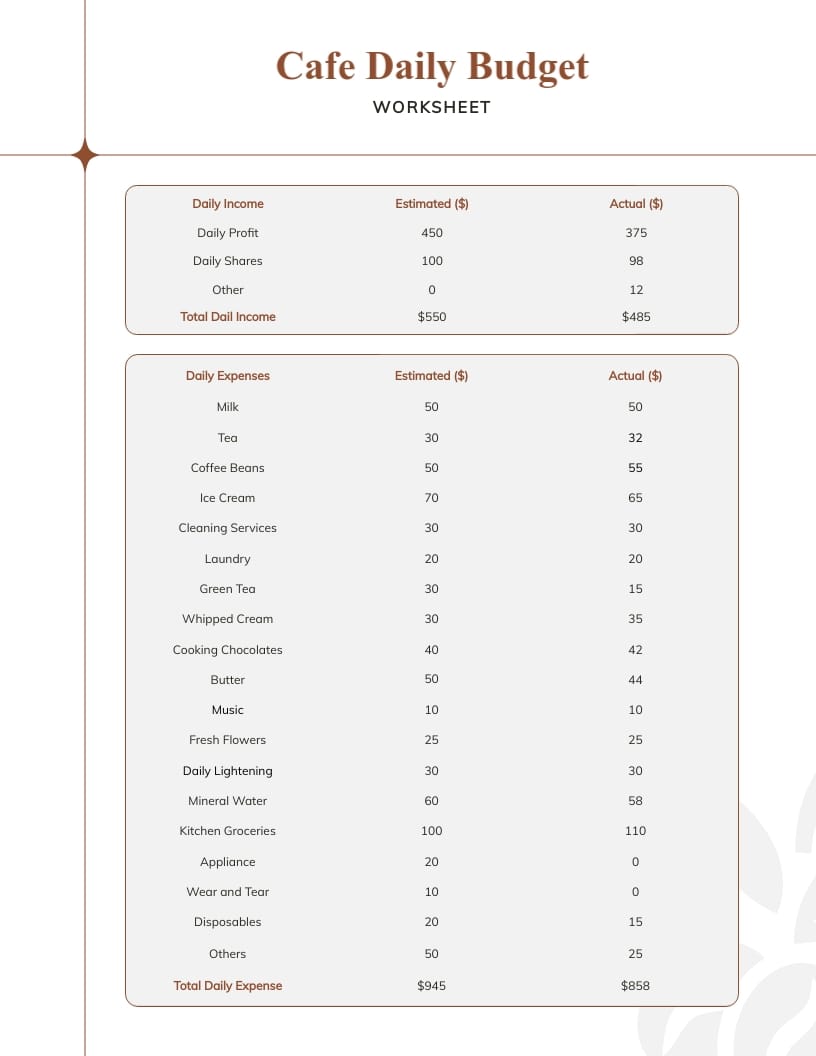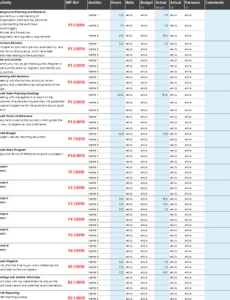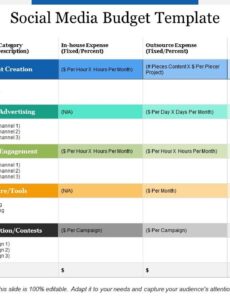The aroma of freshly brewed coffee, the warm glow of inviting lighting, and the murmur of contented customers – for many, opening a cafe is the realization of a cherished dream. It’s a vision of community, connection, and the perfect cup. However, behind every successful cafe’s charm lies a robust and meticulously managed financial operation. The difference between a fleeting dream and a thriving business often boils down to one critical tool: a well-crafted financial plan.
Without a clear financial roadmap, even the most passionate entrepreneur can quickly find their dream turning into a financial nightmare. Cash flow issues, unexpected expenses, and unclear profitability can quickly derail a promising venture. This is where understanding and implementing an effective Cafe Budget Template becomes indispensable, offering a structured approach to managing your finances and ensuring your coffee shop not only survives but flourishes.
Why a Cafe Budget is Your Blueprint for Success
A comprehensive coffee shop budget is more than just a spreadsheet; it’s your business’s financial blueprint, guiding every decision from inventory purchases to marketing initiatives. It provides a clear overview of your income and expenses, allowing you to make informed choices that drive profitability and sustainability. For both aspiring and established cafe owners, this financial tool illuminates the path forward.

Having a robust financial plan helps in several crucial ways. It enables you to anticipate future challenges, allocate resources efficiently, and set realistic financial goals. By tracking where your money comes from and where it goes, you can identify areas for cost savings, optimize pricing strategies, and ultimately improve your bottom line. It transforms guesswork into strategic planning, giving you peace of mind and a clearer vision for growth.
Key Elements of an Effective Cafe Financial Plan
Building a successful coffee business hinges on understanding its financial components. An effective financial plan for a cafe meticulously breaks down all potential revenue streams and expenditures, ensuring nothing is overlooked. Here are the core elements you’ll need to consider when constructing your cafe’s fiscal framework:
- **Revenue Streams:** This includes all sources of income. Think beyond just coffee sales to include items like pastry sales, merchandise, catering services, bottled beverages, and even gift card sales. A detailed breakdown helps project potential earnings accurately.
- **Cost of Goods Sold (COGS):** These are the direct costs associated with the items you sell. For a cafe, this primarily involves raw materials like **coffee beans**, milk, syrups, teas, and food ingredients for any menu items. Tracking COGS is vital for calculating gross profit margins.
- **Operating Expenses:** These are the regular costs of running your business that are not directly tied to production. This category is broad and includes:
- **Rent or Mortgage:** Your monthly occupancy costs.
- **Utilities:** Electricity, gas, water, internet, and trash removal.
- **Labor Costs:** Wages, salaries, benefits, and payroll taxes for all staff members, including baristas, managers, and any kitchen staff.
- **Marketing and Advertising:** Costs associated with promotions, social media campaigns, local advertisements, and loyalty programs.
- **Supplies:** Disposable cups, lids, stirrers, napkins, cleaning supplies, and office supplies.
- **Insurance:** General liability, property, and workers’ compensation insurance.
- **Repairs and Maintenance:** Regular upkeep of equipment and premises.
- **Professional Fees:** Accounting, legal, or consulting services.
- **Fixed vs. Variable Costs:** Differentiating between these is crucial. **Fixed costs** (like rent, insurance, salaries) remain relatively constant regardless of sales volume, while **variable costs** (like COGS, hourly wages tied to sales, utilities for high production) fluctuate with business activity.
- **Capital Expenditures:** These are investments in significant assets that will be used for more than one year, such as espresso machines, grinders, refrigeration units, furniture, and leasehold improvements. While not part of your daily operating budget, they are critical for long-term financial planning.
- **Taxes and Licenses:** Don’t forget sales tax, income tax, business licenses, health permits, and other regulatory fees that are essential for legal operation.
Building Your Cafe’s Fiscal Roadmap: A Step-by-Step Guide
Creating an effective operating budget for a cafe requires a systematic approach. It’s not just about filling in numbers; it’s about strategic thinking and realistic projections. Follow these steps to develop a robust financial framework for cafes that truly reflects your business:
- **Gather Historical Data (if applicable):** If you’re an existing cafe, collect past sales figures, expense reports, and bank statements. This data forms the bedrock for future projections and helps identify trends. New businesses will rely on industry benchmarks and detailed market research.
- **Project Your Revenue:** Be realistic but ambitious. Estimate your average number of customers per day, average spend per customer, and any other income streams. Consider seasonality and special events. Break this down monthly or even weekly.
- **Itemize All Expenses:** Go through every single cost associated with running your cafe, from the smallest cleaning supply to the largest rent payment. Refer to the “Key Elements” section above to ensure comprehensive coverage.
- **Categorize and Classify Costs:** Group your expenses into logical categories (COGS, Labor, Utilities, Marketing, etc.). Clearly identify which costs are fixed and which are variable. This distinction is vital for understanding your break-even point and managing profitability.
- **Allocate Funds and Set Limits:** Assign a specific budget amount to each expense category. This forces you to make conscious decisions about how much you’re willing to spend in each area. Be prepared to adjust these initial allocations as you refine your plan.
- **Build a Contingency Fund:** Unexpected expenses are a reality in any business. Include a line item for a contingency fund, typically 10-15% of your total expenses, to cover unforeseen costs or dips in revenue.
- **Review, Monitor, and Adjust Regularly:** A budget is a living document, not a static report. Review your actual performance against your budgeted figures at least monthly. Identify variances, understand why they occurred, and make necessary adjustments to your spending or revenue strategies.
Leveraging Your Financial Forecast for Growth and Profitability
Beyond merely tracking expenditures, a well-structured coffee business financial planning tool becomes a powerful asset for strategic decision-making. It enables proactive management rather than reactive problem-solving, driving your cafe toward sustained growth and heightened profitability.
Utilize your comprehensive budget to analyze key performance indicators (KPIs), such as cost per cup, average transaction value, and labor cost percentage. This data empowers you to fine-tune your pricing strategies, ensuring your menu items are not only appealing but also profitable. It also highlights areas where cost-saving measures can be implemented without compromising quality, like optimizing inventory management to reduce waste or negotiating better deals with suppliers. Furthermore, a detailed financial forecast is indispensable when seeking external financing, as banks and investors require a clear understanding of your business’s financial health and projections. It demonstrates your foresight and commitment to financial stability, significantly strengthening your case for investment.
Common Pitfalls and How to Avoid Them
Even with the best intentions, cafe owners can fall into common budgeting traps that undermine their financial stability. Recognizing these pitfalls is the first step toward avoiding them, ensuring your profitability planning tool remains effective.
One frequent mistake is underestimating startup costs, leading to insufficient initial capital and immediate cash flow struggles. Be thorough in accounting for everything from permits and renovations to initial inventory and marketing launch expenses. Another pitfall is ignoring small, recurring expenses; these seemingly minor costs can accumulate quickly and significantly impact your budget if not tracked. Furthermore, unrealistic revenue projections can set you up for disappointment and poor decision-making. Base your sales forecasts on solid market research and conservative estimates, especially in the initial months. Finally, failing to build a contingency fund for unexpected events, like equipment breakdowns or sudden market shifts, leaves your business vulnerable. Regularly reviewing and adapting your budget to real-world performance is crucial for long-term success.
Frequently Asked Questions
Is a Cafe Budget Template only for new businesses?
Absolutely not. While essential for startups, an ongoing financial plan is equally vital for established cafes. It helps monitor performance, identify areas for improvement, plan for expansion, and adapt to changing market conditions, ensuring long-term viability and growth.
How often should I update my cafe’s financial plan?
You should review your actual financial performance against your budget at least monthly. Make minor adjustments to your forecast as needed. A comprehensive revision of the entire financial plan should occur annually, or whenever significant changes happen in your business model, market, or economic environment.
What’s the biggest mistake cafe owners make with their budgets?
One of the most common and damaging mistakes is creating a budget and then failing to regularly monitor it or make adjustments. A budget is a living document that needs consistent attention and flexibility to be truly effective. Without ongoing review, it becomes a static document with little practical value.
Can a budget template help with securing a loan?
Yes, definitively. Lenders and investors require a clear understanding of your business’s financial health and prospects. A well-prepared and detailed operating budget demonstrates your financial acumen, your understanding of the business’s potential, and your ability to manage finances responsibly, significantly increasing your chances of securing funding.
Where can I find a reliable budgeting tool for coffee shops?
There are many resources available, from free online spreadsheet templates to sophisticated accounting software with budgeting features. You can adapt general business budget templates, look for industry-specific templates, or even consult with a financial advisor who specializes in small businesses to help you create a custom Cafe Budget Template tailored to your unique needs.
The journey of building and sustaining a successful cafe is incredibly rewarding, but it demands more than just a passion for coffee. It requires sharp financial acumen, grounded in a clear and actionable financial plan. Embracing the discipline of budgeting, monitoring, and adapting your financial framework will provide the stability and insight needed to navigate challenges and seize opportunities.
By treating your cafe’s budget as an indispensable partner in your business, you empower yourself to make smarter decisions, foster growth, and build a resilient coffee shop that not only delights customers but also achieves its full financial potential. Start crafting your comprehensive financial roadmap today, and watch your cafe thrive for years to come.









